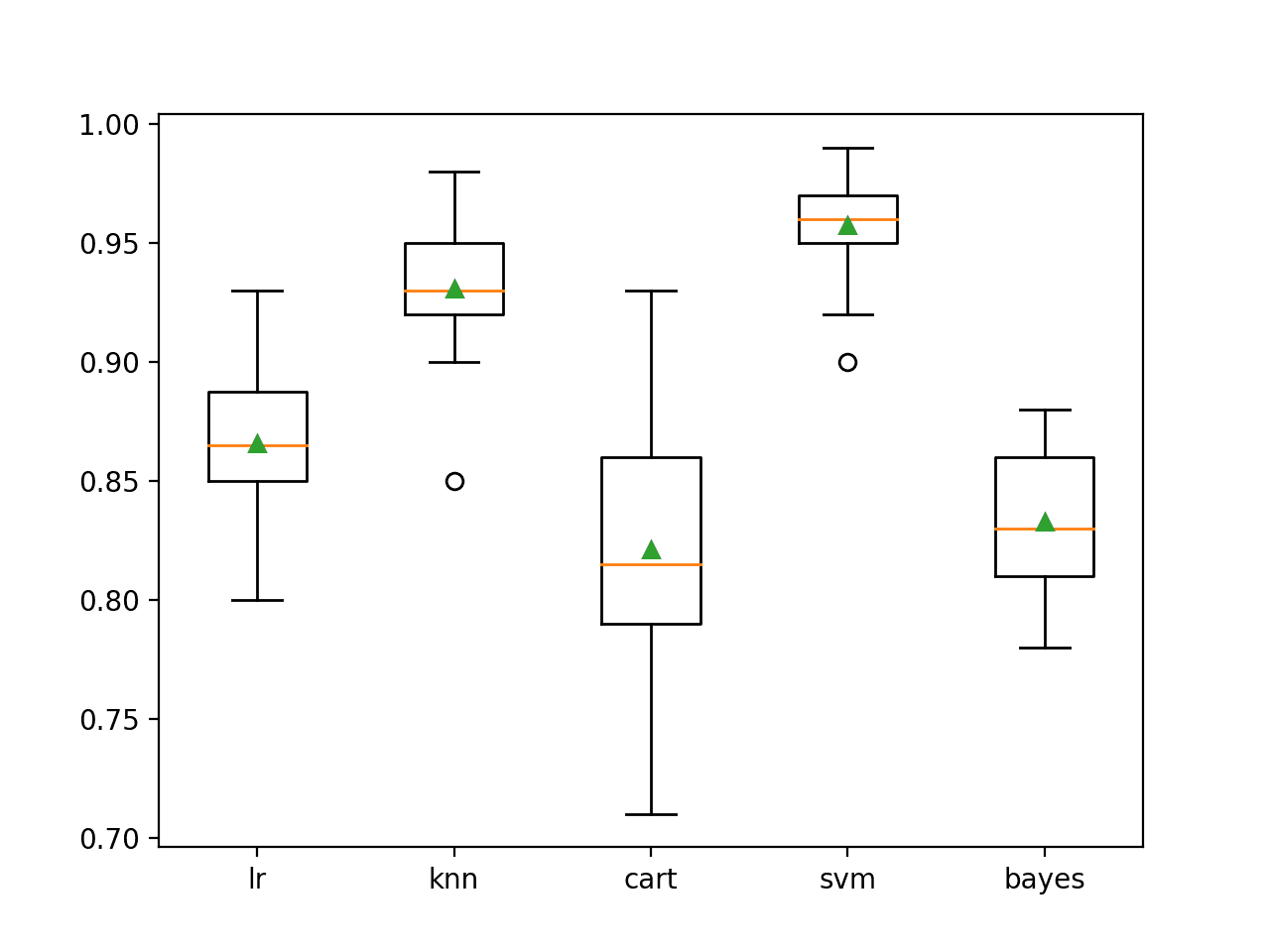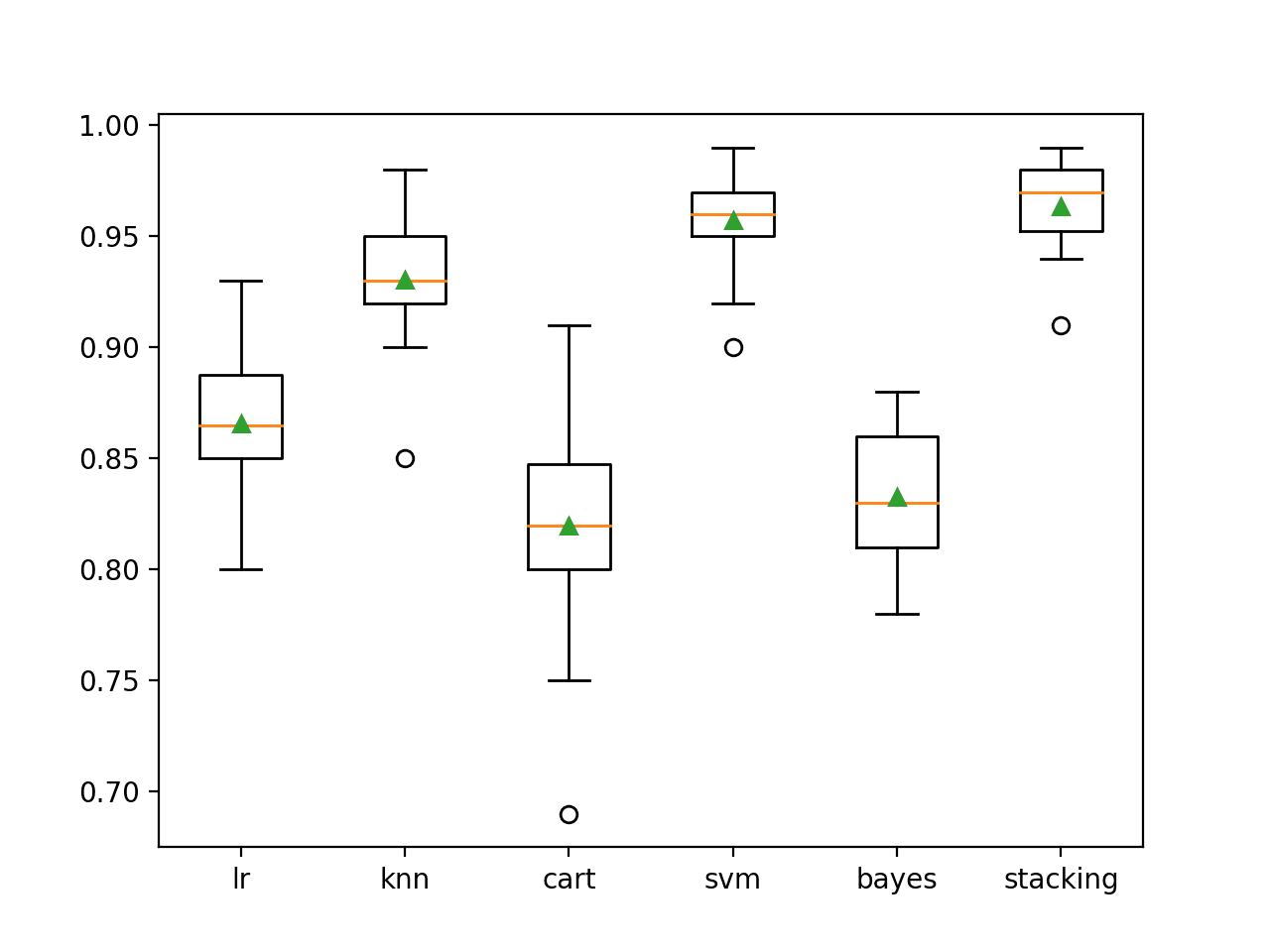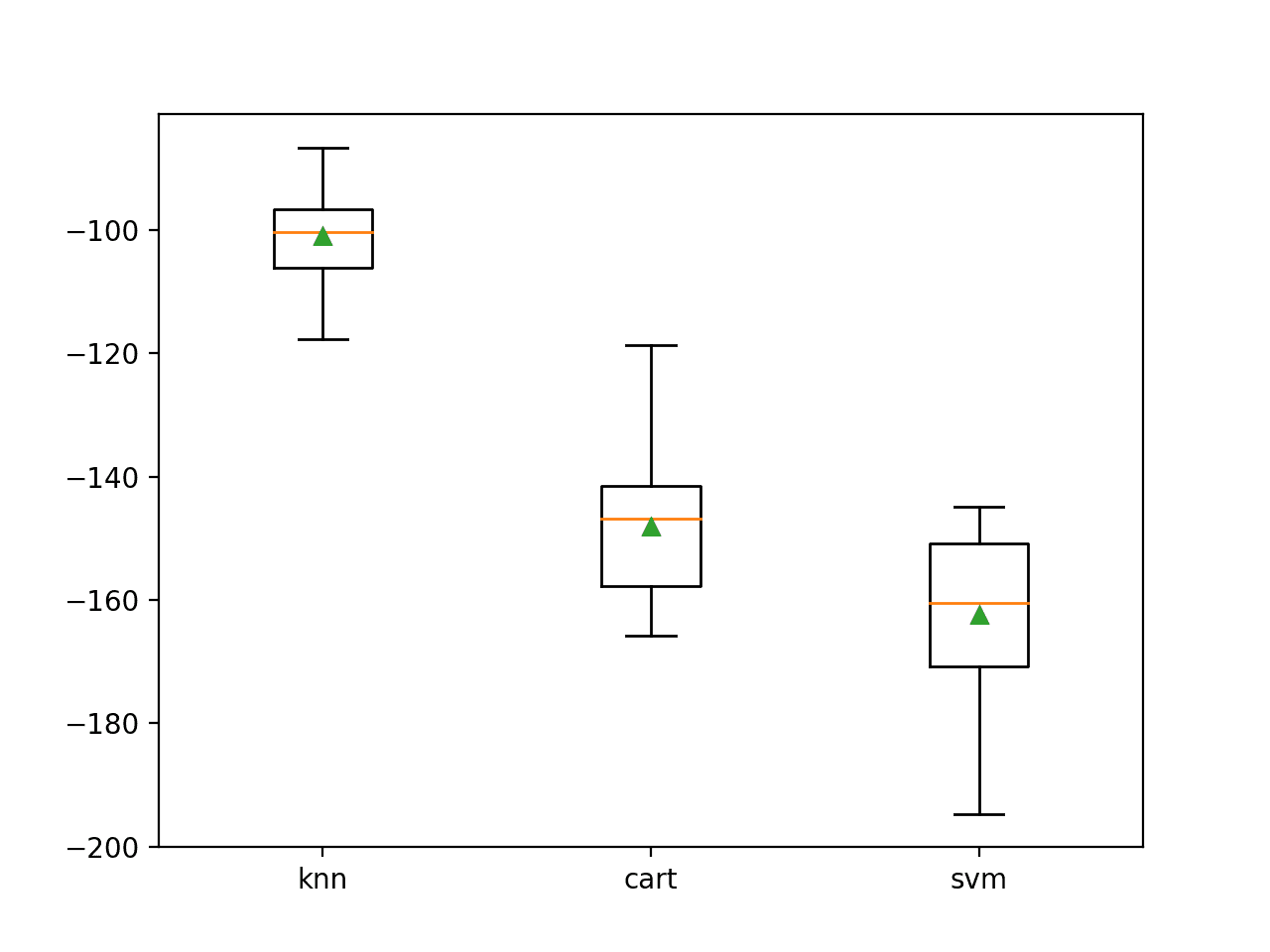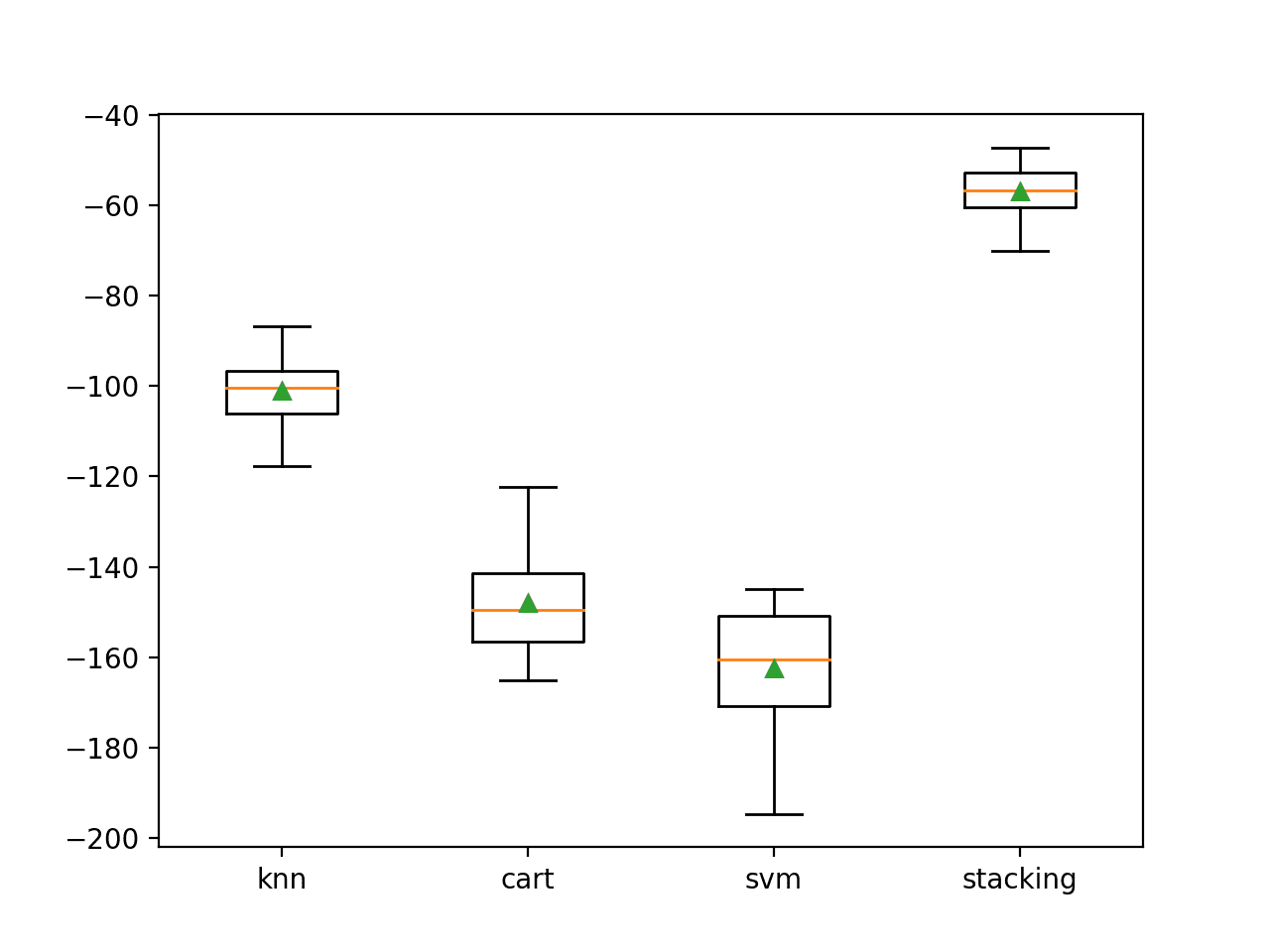Author: Jason Brownlee
Stacking or Stacked Generalization is an ensemble machine learning algorithm.
It uses a meta-learning algorithm to learn how to best combine the predictions from two or more base machine learning algorithms.
The benefit of stacking is that it can harness the capabilities of a range of well-performing models on a classification or regression task and make predictions that have better performance than any single model in the ensemble.
In this tutorial, you will discover the stacked generalization ensemble or stacking in Python.
After completing this tutorial, you will know:
- Stacking is an ensemble machine learning algorithm that learns how to best combine the predictions from multiple well-performing machine learning models.
- The scikit-learn library provides a standard implementation of the stacking ensemble in Python.
- How to use stacking ensembles for regression and classification predictive modeling.
Let’s get started.

Stacking Ensemble Machine Learning With Python
Photo by lamoix, some rights reserved.
Tutorial Overview
This tutorial is divided into four parts; they are:
- Stacked Generalization
- Stacking Scikit-Learn API
- Stacking for Classification
- Stacking for Regression
Stacked Generalization
Stacked Generalization or “Stacking” for short is an ensemble machine learning algorithm.
It involves combining the predictions from multiple machine learning models on the same dataset, like bagging and boosting.
Stacking addresses the question:
- Given multiple machine learning models that are skillful on a problem, but in different ways, how do you choose which model to use (trust)?
The approach to this question is to use another machine learning model that learns when to use or trust each model in the ensemble.
- Unlike bagging, in stacking, the models are typically different (e.g. not all decision trees) and fit on the same dataset (e.g. instead of samples of the training dataset).
- Unlike boosting, in stacking, a single model is used to learn how to best combine the predictions from the contributing models (e.g. instead of a sequence of models that correct the predictions of prior models).
The architecture of a stacking model involves two or more base models, often referred to as level-0 models, and a meta-model that combines the predictions of the base models, referred to as a level-1 model.
- Level-0 Models (Base-Models): Models fit on the training data and whose predictions are compiled.
- Level-1 Model (Meta-Model): Model that learns how to best combine the predictions of the base models.
The meta-model is trained on the predictions made by base models on out-of-sample data. That is, data not used to train the base models is fed to the base models, predictions are made, and these predictions, along with the expected outputs, provide the input and output pairs of the training dataset used to fit the meta-model.
The outputs from the base models used as input to the meta-model may be real value in the case of regression, and probability values, probability like values, or class labels in the case of classification.
The most common approach to preparing the training dataset for the meta-model is via k-fold cross-validation of the base models, where the out-of-fold predictions are used as the basis for the training dataset for the meta-model.
The training data for the meta-model may also include the inputs to the base models, e.g. input elements of the training data. This can provide an additional context to the meta-model as to how to best combine the predictions from the meta-model.
Once the training dataset is prepared for the meta-model, the meta-model can be trained in isolation on this dataset, and the base-models can be trained on the entire original training dataset.
Stacking is appropriate when multiple different machine learning models have skill on a dataset, but have skill in different ways. Another way to say this is that the predictions made by the models or the errors in predictions made by the models are uncorrelated or have a low correlation.
Base-models are often complex and diverse. As such, it is often a good idea to use a range of models that make very different assumptions about how to solve the predictive modeling task, such as linear models, decision trees, support vector machines, neural networks, and more. Other ensemble algorithms may also be used as base-models, such as random forests.
- Base-Models: Use a diverse range of models that make different assumptions about the prediction task.
The meta-model is often simple, providing a smooth interpretation of the predictions made by the base models. As such, linear models are often used as the meta-model, such as linear regression for regression tasks (predicting a numeric value) and logistic regression for classification tasks (predicting a class label). Although this is common, it is not required.
- Regression Meta-Model: Linear Regression.
- Classification Meta-Model: Logistic Regression.
The use of a simple linear model as the meta-model often gives stacking the colloquial name “blending.” As in the prediction is a weighted average or blending of the predictions made by the base models.
The super learner may be considered a specialized type of stacking.
Stacking is designed to improve modeling performance, although is not guaranteed to result in an improvement in all cases.
Achieving an improvement in performance depends on the complexity of the problem and whether it is sufficiently well represented by the training data and complex enough that there is more to learn by combining predictions. It is also dependent upon the choice of base models and whether they are sufficiently skillful and sufficiently uncorrelated in their predictions (or errors).
If a base-model performs as well as or better than the stacking ensemble, the base model should be used instead, given its lower complexity (e.g. it’s simpler to describe, train and maintain).
Stacking Scikit-Learn API
Stacking can be implemented from scratch, although this can be challenging for beginners.
For an example of implementing stacking from scratch in Python, see the tutorial:
For an example of implementing stacking from scratch for deep learning, see the tutorial:
The scikit-learn Python machine learning library provides an implementation of stacking for machine learning.
It is available in version 0.22 of the library and higher.
First, confirm that you are using a modern version of the library by running the following script:
# check scikit-learn version import sklearn print(sklearn.__version__)
Running the script will print your version of scikit-learn.
Your version should be the same or higher. If not, you must upgrade your version of the scikit-learn library.
0.22.1
Stacking is provided via the StackingRegressor and StackingClassifier classes.
Both models operate the same way and take the same arguments. Using the model requires that you specify a list of estimators (level-0 models), and a final estimator (level-1 or meta-model).
A list of level-0 models or base models is provided via the “estimators” argument. This is a Python list where each element in the list is a tuple with the name of the model and the configured model instance.
For example, below defines two level-0 models:
...
models = [('lr',LogisticRegression()),('svm',SVC())
stacking = StackingClassifier(estimators=models]
Each model in the list may also be a Pipeline, including any data preparation required by the model prior to fitting the model on the training dataset. For example:
...
models = [('lr',LogisticRegression()),('svm',make_pipeline(StandardScaler(),SVC()))
stacking = StackingClassifier(estimators=models]
The level-1 model or meta-model is provided via the “final_estimator” argument. By default, this is set to LinearRegression for regression and LogisticRegression for classification, and these are sensible defaults that you probably do not want to change.
The dataset for the meta-model is prepared using cross-validation. By default, 5-fold cross-validation is used, although this can be changed via the “cv” argument and set to either a number (e.g. 10 for 10-fold cross-validation) or a cross-validation object (e.g. StratifiedKFold).
Sometimes, better performance can be achieved if the dataset prepared for the meta-model also includes inputs to the level-0 models, e.g. the input training data. This can be achieved by setting the “passthrough” argument to True and is not enabled by default.
Now that we are familiar with the stacking API in scikit-learn, let’s look at some worked examples.
Stacking for Classification
In this section, we will look at using stacking for a classification problem.
First, we can use the make_classification() function to create a synthetic binary classification problem with 1,000 examples and 20 input features.
The complete example is listed below.
# test classification dataset from sklearn.datasets import make_classification # define dataset X, y = make_classification(n_samples=1000, n_features=20, n_informative=15, n_redundant=5, random_state=1) # summarize the dataset print(X.shape, y.shape)
Running the example creates the dataset and summarizes the shape of the input and output components.
(1000, 20) (1000,)
Next, we can evaluate a suite of different machine learning models on the dataset.
Specifically, we will evaluate the following five algorithms:
- Logistic Regression.
- k-Nearest Neighbors.
- Decision Tree.
- Support Vector Machine.
- Naive Bayes.
Each algorithm will be evaluated using default model hyperparameters. The function get_models() below creates the models we wish to evaluate.
# get a list of models to evaluate def get_models(): models = dict() models['lr'] = LogisticRegression() models['knn'] = KNeighborsClassifier() models['cart'] = DecisionTreeClassifier() models['svm'] = SVC() models['bayes'] = GaussianNB() return models
Each model will be evaluated using repeated k-fold cross-validation.
The evaluate_model() function below takes a model instance and returns a list of scores from three repeats of stratified 10-fold cross-validation.
# evaluate a given model using cross-validation def evaluate_model(model): cv = RepeatedStratifiedKFold(n_splits=10, n_repeats=3, random_state=1) scores = cross_val_score(model, X, y, scoring='accuracy', cv=cv, n_jobs=-1, error_score='raise') return scores
We can then report the mean performance of each algorithm and also create a box and whisker plot to compare the distribution of accuracy scores for each algorithm.
Tying this together, the complete example is listed below.
# compare standalone models for binary classification
from numpy import mean
from numpy import std
from sklearn.datasets import make_classification
from sklearn.model_selection import cross_val_score
from sklearn.model_selection import RepeatedStratifiedKFold
from sklearn.linear_model import LogisticRegression
from sklearn.neighbors import KNeighborsClassifier
from sklearn.tree import DecisionTreeClassifier
from sklearn.svm import SVC
from sklearn.naive_bayes import GaussianNB
from matplotlib import pyplot
# get the dataset
def get_dataset():
X, y = make_classification(n_samples=1000, n_features=20, n_informative=15, n_redundant=5, random_state=1)
return X, y
# get a list of models to evaluate
def get_models():
models = dict()
models['lr'] = LogisticRegression()
models['knn'] = KNeighborsClassifier()
models['cart'] = DecisionTreeClassifier()
models['svm'] = SVC()
models['bayes'] = GaussianNB()
return models
# evaluate a given model using cross-validation
def evaluate_model(model):
cv = RepeatedStratifiedKFold(n_splits=10, n_repeats=3, random_state=1)
scores = cross_val_score(model, X, y, scoring='accuracy', cv=cv, n_jobs=-1, error_score='raise')
return scores
# define dataset
X, y = get_dataset()
# get the models to evaluate
models = get_models()
# evaluate the models and store results
results, names = list(), list()
for name, model in models.items():
scores = evaluate_model(model)
results.append(scores)
names.append(name)
print('>%s %.3f (%.3f)' % (name, mean(scores), std(scores)))
# plot model performance for comparison
pyplot.boxplot(results, labels=names, showmeans=True)
pyplot.show()
Running the example first reports the mean and standard deviation accuracy for each model.
We can see that in this case, SVM performs the best with about 95.7 percent mean accuracy.
>lr 0.866 (0.029) >knn 0.931 (0.025) >cart 0.821 (0.050) >svm 0.957 (0.020) >bayes 0.833 (0.031)
A box-and-whisker plot is then created comparing the distribution accuracy scores for each model, allowing us to clearly see that KNN and SVM perform better on average than LR, CART, and Bayes.

Box Plot of Standalone Model Accuracies for Binary Classification
Here we have five different algorithms that perform well, presumably in different ways on this dataset.
Next, we can try to combine these five models into a single ensemble model using stacking.
We can use a logistic regression model to learn how to best combine the predictions from each of the separate five models.
The get_stacking() function below defines the StackingClassifier model by first defining a list of tuples for the five base models, then defining the logistic regression meta-model to combine the predictions from the base models using 5-fold cross-validation.
# get a stacking ensemble of models
def get_stacking():
# define the base models
level0 = list()
level0.append(('lr', LogisticRegression()))
level0.append(('knn', KNeighborsClassifier()))
level0.append(('cart', DecisionTreeClassifier()))
level0.append(('svm', SVC()))
level0.append(('bayes', GaussianNB()))
# define meta learner model
level1 = LogisticRegression()
# define the stacking ensemble
model = StackingClassifier(estimators=level0, final_estimator=level1, cv=5)
return model
We can include the stacking ensemble in the list of models to evaluate, along with the standalone models.
# get a list of models to evaluate def get_models(): models = dict() models['lr'] = LogisticRegression() models['knn'] = KNeighborsClassifier() models['cart'] = DecisionTreeClassifier() models['svm'] = SVC() models['bayes'] = GaussianNB() models['stacking'] = get_stacking() return models
Our expectation is that the stacking ensemble will perform better than any single base model.
This is not always the case and if it is not the case, then the base model should be used in favor of the ensemble model.
The complete example of evaluating the stacking ensemble model alongside the standalone models is listed below.
# compare ensemble to each baseline classifier
from numpy import mean
from numpy import std
from sklearn.datasets import make_classification
from sklearn.model_selection import cross_val_score
from sklearn.model_selection import RepeatedStratifiedKFold
from sklearn.linear_model import LogisticRegression
from sklearn.neighbors import KNeighborsClassifier
from sklearn.tree import DecisionTreeClassifier
from sklearn.svm import SVC
from sklearn.naive_bayes import GaussianNB
from sklearn.ensemble import StackingClassifier
from matplotlib import pyplot
# get the dataset
def get_dataset():
X, y = make_classification(n_samples=1000, n_features=20, n_informative=15, n_redundant=5, random_state=1)
return X, y
# get a stacking ensemble of models
def get_stacking():
# define the base models
level0 = list()
level0.append(('lr', LogisticRegression()))
level0.append(('knn', KNeighborsClassifier()))
level0.append(('cart', DecisionTreeClassifier()))
level0.append(('svm', SVC()))
level0.append(('bayes', GaussianNB()))
# define meta learner model
level1 = LogisticRegression()
# define the stacking ensemble
model = StackingClassifier(estimators=level0, final_estimator=level1, cv=5)
return model
# get a list of models to evaluate
def get_models():
models = dict()
models['lr'] = LogisticRegression()
models['knn'] = KNeighborsClassifier()
models['cart'] = DecisionTreeClassifier()
models['svm'] = SVC()
models['bayes'] = GaussianNB()
models['stacking'] = get_stacking()
return models
# evaluate a give model using cross-validation
def evaluate_model(model):
cv = RepeatedStratifiedKFold(n_splits=10, n_repeats=3, random_state=1)
scores = cross_val_score(model, X, y, scoring='accuracy', cv=cv, n_jobs=-1, error_score='raise')
return scores
# define dataset
X, y = get_dataset()
# get the models to evaluate
models = get_models()
# evaluate the models and store results
results, names = list(), list()
for name, model in models.items():
scores = evaluate_model(model)
results.append(scores)
names.append(name)
print('>%s %.3f (%.3f)' % (name, mean(scores), std(scores)))
# plot model performance for comparison
pyplot.boxplot(results, labels=names, showmeans=True)
pyplot.show()
Running the example first reports the performance of each model.
This includes the performance of each base model, then the stacking ensemble.
In this case, we can see that the stacking ensemble appears to perform better than any single model on average, achieving an accuracy of about 96.4 percent.
>lr 0.866 (0.029) >knn 0.931 (0.025) >cart 0.820 (0.044) >svm 0.957 (0.020) >bayes 0.833 (0.031) >stacking 0.964 (0.019)
A box plot is created showing the distribution of model classification accuracies.
Here, we can see that the mean and median accuracy for the stacking model sits slightly higher than the SVM model.

Box Plot of Standalone and Stacking Model Accuracies for Binary Classification
If we choose a stacking ensemble as our final model, we can fit and use it to make predictions on new data just like any other model.
First, the stacking ensemble is fit on all available data, then the predict() function can be called to make predictions on new data.
The example below demonstrates this on our binary classification dataset.
# make a prediction with a stacking ensemble
from sklearn.datasets import make_classification
from sklearn.ensemble import StackingClassifier
from sklearn.linear_model import LogisticRegression
from sklearn.neighbors import KNeighborsClassifier
from sklearn.tree import DecisionTreeClassifier
from sklearn.svm import SVC
from sklearn.naive_bayes import GaussianNB
# define dataset
X, y = make_classification(n_samples=1000, n_features=20, n_informative=15, n_redundant=5, random_state=1)
# define the base models
level0 = list()
level0.append(('lr', LogisticRegression()))
level0.append(('knn', KNeighborsClassifier()))
level0.append(('cart', DecisionTreeClassifier()))
level0.append(('svm', SVC()))
level0.append(('bayes', GaussianNB()))
# define meta learner model
level1 = LogisticRegression()
# define the stacking ensemble
model = StackingClassifier(estimators=level0, final_estimator=level1, cv=5)
# fit the model on all available data
model.fit(X, y)
# make a prediction for one example
data = [[2.47475454,0.40165523,1.68081787,2.88940715,0.91704519,-3.07950644,4.39961206,0.72464273,-4.86563631,-6.06338084,-1.22209949,-0.4699618,1.01222748,-0.6899355,-0.53000581,6.86966784,-3.27211075,-6.59044146,-2.21290585,-3.139579]]
yhat = model.predict(data)
print('Predicted Class: %d' % (yhat))
Running the example fits the stacking ensemble model on the entire dataset and is then used to make a prediction on a new row of data, as we might when using the model in an application.
Predicted Class: 0
Stacking for Regression
In this section, we will look at using stacking for a regression problem.
First, we can use the make_regression() function to create a synthetic regression problem with 1,000 examples and 20 input features.
The complete example is listed below.
# test regression dataset from sklearn.datasets import make_regression # define dataset X, y = make_regression(n_samples=1000, n_features=20, n_informative=15, noise=0.1, random_state=1) # summarize the dataset print(X.shape, y.shape)
Running the example creates the dataset and summarizes the shape of the input and output components.
(1000, 20) (1000,)
Next, we can evaluate a suite of different machine learning models on the dataset.
Specifically, we will evaluate the following three algorithms:
- k-Nearest Neighbors.
- Decision Tree.
- Support Vector Regression.
Note: The test dataset can be trivially solved using a linear regression model as the dataset was created using a linear model under the covers. As such, we will leave this model out of the example so we can demonstrate the benefit of the stacking ensemble method.
Each algorithm will be evaluated using the default model hyperparameters. The function get_models() below creates the models we wish to evaluate.
# get a list of models to evaluate def get_models(): models = dict() models['knn'] = KNeighborsRegressor() models['cart'] = DecisionTreeRegressor() models['svm'] = SVR() return models
Each model will be evaluated using repeated k-fold cross-validation. The evaluate_model() function below takes a model instance and returns a list of scores from three repeats of 10-fold cross-validation.
# evaluate a given model using cross-validation def evaluate_model(model): cv = RepeatedKFold(n_splits=10, n_repeats=3, random_state=1) scores = cross_val_score(model, X, y, scoring='neg_mean_absolute_error', cv=cv, n_jobs=-1, error_score='raise') return scores
We can then report the mean performance of each algorithm and also create a box and whisker plot to compare the distribution of accuracy scores for each algorithm.
In this case, model performance will be reported using the mean absolute error (MAE). The scikit-learn library inverts the sign on this error to make it maximizing, from -infinity to 0 for the best score.
Tying this together, the complete example is listed below.
# compare machine learning models for regression
from numpy import mean
from numpy import std
from sklearn.datasets import make_regression
from sklearn.model_selection import cross_val_score
from sklearn.model_selection import RepeatedKFold
from sklearn.linear_model import LinearRegression
from sklearn.neighbors import KNeighborsRegressor
from sklearn.tree import DecisionTreeRegressor
from sklearn.svm import SVR
from matplotlib import pyplot
# get the dataset
def get_dataset():
X, y = make_regression(n_samples=1000, n_features=20, n_informative=15, noise=0.1, random_state=1)
return X, y
# get a list of models to evaluate
def get_models():
models = dict()
models['knn'] = KNeighborsRegressor()
models['cart'] = DecisionTreeRegressor()
models['svm'] = SVR()
return models
# evaluate a given model using cross-validation
def evaluate_model(model):
cv = RepeatedKFold(n_splits=10, n_repeats=3, random_state=1)
scores = cross_val_score(model, X, y, scoring='neg_mean_absolute_error', cv=cv, n_jobs=-1, error_score='raise')
return scores
# define dataset
X, y = get_dataset()
# get the models to evaluate
models = get_models()
# evaluate the models and store results
results, names = list(), list()
for name, model in models.items():
scores = evaluate_model(model)
results.append(scores)
names.append(name)
print('>%s %.3f (%.3f)' % (name, mean(scores), std(scores)))
# plot model performance for comparison
pyplot.boxplot(results, labels=names, showmeans=True)
pyplot.show()
Running the example first reports the mean and standard deviation MAE for each model.
We can see that in this case, KNN performs the best with a mean negative MAE of about -100.
>knn -101.019 (7.161) >cart -148.100 (11.039) >svm -162.419 (12.565)
A box-and-whisker plot is then created comparing the distribution negative MAE scores for each model.

Box Plot of Standalone Model Negative Mean Absolute Error for Regression
Here we have three different algorithms that perform well, presumably in different ways on this dataset.
Next, we can try to combine these three models into a single ensemble model using stacking.
We can use a linear regression model to learn how to best combine the predictions from each of the separate three models.
The get_stacking() function below defines the StackingRegressor model by first defining a list of tuples for the three base models, then defining the linear regression meta-model to combine the predictions from the base models using 5-fold cross-validation.
# get a stacking ensemble of models
def get_stacking():
# define the base models
level0 = list()
level0.append(('knn', KNeighborsRegressor()))
level0.append(('cart', DecisionTreeRegressor()))
level0.append(('svm', SVR()))
# define meta learner model
level1 = LinearRegression()
# define the stacking ensemble
model = StackingRegressor(estimators=level0, final_estimator=level1, cv=5)
return model
We can include the stacking ensemble in the list of models to evaluate, along with the standalone models.
# get a list of models to evaluate def get_models(): models = dict() models['knn'] = KNeighborsRegressor() models['cart'] = DecisionTreeRegressor() models['svm'] = SVR() models['stacking'] = get_stacking() return models
Our expectation is that the stacking ensemble will perform better than any single base model.
This is not always the case, and if it is not the case, then the base model should be used in favor of the ensemble model.
The complete example of evaluating the stacking ensemble model alongside the standalone models is listed below.
# compare ensemble to each standalone models for regression
from numpy import mean
from numpy import std
from sklearn.datasets import make_regression
from sklearn.model_selection import cross_val_score
from sklearn.model_selection import RepeatedKFold
from sklearn.linear_model import LinearRegression
from sklearn.neighbors import KNeighborsRegressor
from sklearn.tree import DecisionTreeRegressor
from sklearn.svm import SVR
from sklearn.ensemble import StackingRegressor
from matplotlib import pyplot
# get the dataset
def get_dataset():
X, y = make_regression(n_samples=1000, n_features=20, n_informative=15, noise=0.1, random_state=1)
return X, y
# get a stacking ensemble of models
def get_stacking():
# define the base models
level0 = list()
level0.append(('knn', KNeighborsRegressor()))
level0.append(('cart', DecisionTreeRegressor()))
level0.append(('svm', SVR()))
# define meta learner model
level1 = LinearRegression()
# define the stacking ensemble
model = StackingRegressor(estimators=level0, final_estimator=level1, cv=5)
return model
# get a list of models to evaluate
def get_models():
models = dict()
models['knn'] = KNeighborsRegressor()
models['cart'] = DecisionTreeRegressor()
models['svm'] = SVR()
models['stacking'] = get_stacking()
return models
# evaluate a given model using cross-validation
def evaluate_model(model):
cv = RepeatedKFold(n_splits=10, n_repeats=3, random_state=1)
scores = cross_val_score(model, X, y, scoring='neg_mean_absolute_error', cv=cv, n_jobs=-1, error_score='raise')
return scores
# define dataset
X, y = get_dataset()
# get the models to evaluate
models = get_models()
# evaluate the models and store results
results, names = list(), list()
for name, model in models.items():
scores = evaluate_model(model)
results.append(scores)
names.append(name)
print('>%s %.3f (%.3f)' % (name, mean(scores), std(scores)))
# plot model performance for comparison
pyplot.boxplot(results, labels=names, showmeans=True)
pyplot.show()
Running the example first reports the performance of each model. This includes the performance of each base model, then the stacking ensemble.
In this case, we can see that the stacking ensemble appears to perform better than any single model on average, achieving a mean negative MAE of about -56.
>knn -101.019 (7.161) >cart -148.017 (10.635) >svm -162.419 (12.565) >stacking -56.893 (5.253)
A box plot is created showing the distribution of model error scores. Here, we can see that the mean and median scores for the stacking model sit much higher than any individual model.

Box Plot of Standalone and Stacking Model Negative Mean Absolute Error for Regression
If we choose a stacking ensemble as our final model, we can fit and use it to make predictions on new data just like any other model.
First, the stacking ensemble is fit on all available data, then the predict() function can be called to make predictions on new data.
The example below demonstrates this on our regression dataset.
# make a prediction with a stacking ensemble
from sklearn.datasets import make_regression
from sklearn.linear_model import LinearRegression
from sklearn.neighbors import KNeighborsRegressor
from sklearn.tree import DecisionTreeRegressor
from sklearn.svm import SVR
from sklearn.ensemble import StackingRegressor
# define dataset
X, y = make_regression(n_samples=1000, n_features=20, n_informative=15, noise=0.1, random_state=1)
# define the base models
level0 = list()
level0.append(('knn', KNeighborsRegressor()))
level0.append(('cart', DecisionTreeRegressor()))
level0.append(('svm', SVR()))
# define meta learner model
level1 = LinearRegression()
# define the stacking ensemble
model = StackingRegressor(estimators=level0, final_estimator=level1, cv=5)
# fit the model on all available data
model.fit(X, y)
# make a prediction for one example
data = [[0.59332206,-0.56637507,1.34808718,-0.57054047,-0.72480487,1.05648449,0.77744852,0.07361796,0.88398267,2.02843157,1.01902732,0.11227799,0.94218853,0.26741783,0.91458143,-0.72759572,1.08842814,-0.61450942,-0.69387293,1.69169009]]
yhat = model.predict(data)
print('Predicted Value: %.3f' % (yhat))
Running the example fits the stacking ensemble model on the entire dataset and is then used to make a prediction on a new row of data, as we might when using the model in an application.
Predicted Value: 556.264
Further Reading
This section provides more resources on the topic if you are looking to go deeper.
Tutorials
- How to Implement Stacked Generalization (Stacking) From Scratch With Python
- How to Develop a Stacking Ensemble for Deep Learning Neural Networks in Python With Keras
- How to Develop Super Learner Ensembles in Python
- How to Use Out-of-Fold Predictions in Machine Learning
- A Gentle Introduction to k-fold Cross-Validation
Books
- Data Mining: Practical Machine Learning Tools and Techniques, 2016.
- The Elements of Statistical Learning, 2017.
- Machine Learning: A Probabilistic Perspective, 2012.
APIs
- sklearn.ensemble.StackingClassifier API.
- sklearn.ensemble.StackingRegressor API.
- sklearn.datasets.make_classification API.
- sklearn.datasets.make_regression API.
Articles
Summary
In this tutorial, you discovered the stacked generalization ensemble or stacking in Python.
Specifically, you learned:
- Stacking is an ensemble machine learning algorithm that learns how to best combine the predictions from multiple well-performing machine learning models.
- The scikit-learn library provides a standard implementation of the stacking ensemble in Python.
- How to use stacking ensembles for regression and classification predictive modeling.
Do you have any questions?
Ask your questions in the comments below and I will do my best to answer.
The post Stacking Ensemble Machine Learning With Python appeared first on Machine Learning Mastery.
